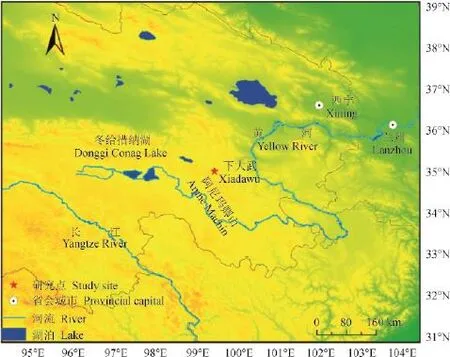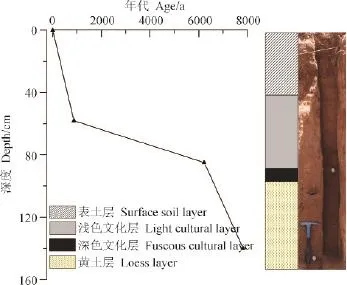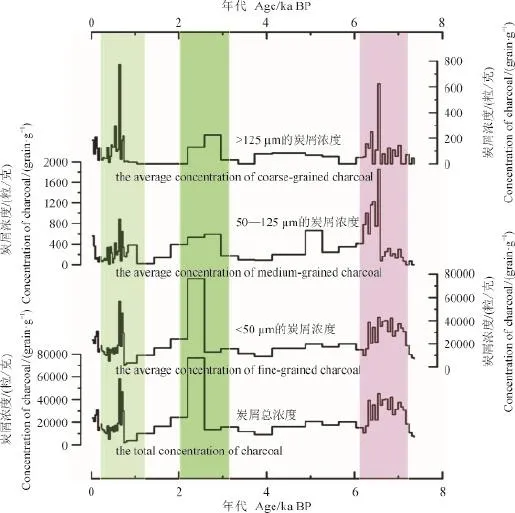青藏高原下大武地区炭屑浓度所反映的环境演变与人类活动
赵亚娟,候光良,鄂崇毅,杨 龙,王青波
(1.青海师范大学 青藏高原环境与资源教育部重点实验室,西宁 810008;2.青海师范大学 青海省自然地理与环境过程重点实验室,西宁 810008)
青藏高原下大武地区炭屑浓度所反映的环境演变与人类活动
赵亚娟1,2,候光良1,2,鄂崇毅1,2,杨 龙1,2,王青波1,2
(1.青海师范大学 青藏高原环境与资源教育部重点实验室,西宁 810008;2.青海师范大学 青海省自然地理与环境过程重点实验室,西宁 810008)
青藏高原主体海拔在4000 m以上,4000 m以上的人类活动与环境演变之间的关系研究很薄弱。本文通过对下大武遗址各粒级炭屑浓度的分析,试探讨其与人类活动和环境的关系。研究发现:(1)全新世大暖期时,气候温暖湿润,适宜生存。在对应的历史文化层中各粒级炭屑浓度出现高值区,说明此时下大武地区人类活动频繁,地方火和区域火频繁出现。(2)全新世中期,季风减弱,气候向冷干转变,植被退化,炭屑浓度普遍处于稳定的低值区,反映当时下大武地区人类活动的强度与范围缩小。(3)全新世晚期以来,3700—1800 cal.a BP炭屑浓度出现明显高值区,指示高原区域火的发生;1800 cal.a BP以来各粒级炭屑浓度波动频繁,粗粒炭屑浓度的波幅最大,指示下大武地区人类活动增强。
炭屑;环境;人类活动;下大武;青藏高原
火作为一种独特且重要的生态环境因子,无论在过去还是现在,都对环境产生着重要影响。火演化记录不仅是研究植被与生态的重要依据,也是反映气候变化的重要指标之一(李小强等,2006)。炭屑是植物有机体不完全燃烧的产物,常被风和流水从产生地带到沉积地保存下来(曹艳峰等,2007),作为火与植被作用的直接产物,是重建古森林火灾历史与古植被的首要证据之一(Patterson et al,1987;MacDonald et al,1991;Millspaugh and Whitlock,1995)。炭屑的产生不仅与自然火的发生有关,还与人类活动密切相关。炭屑含量的变化不仅可以指示气候变化,而且可以反映研究区人口数量和人类活动强度的变化(Figueiral and Mosbrugger,2000),因此,炭屑不仅可以用来恢复古火灾,还可以指示人类活动的强弱(郭小丽等,2011),炭屑研究对探讨古野火、气候与人类活动之间相互作用机制具有重要意义。目前对古环境中炭屑的研究主要集中在以下几个方面:(1)炭屑的提取过程;(2)炭屑的种属鉴定,通过对炭屑最大长度(L)和最大宽度(W)比值的分析,能够初步分析草本植物和木本植物的差别:草本的L/W最大,灌木和乔木次之,阔叶类植物叶片炭屑的L/W最小(张健平和吕厚远,2006);(3)炭屑统计:炭屑浓度法(曹艳峰等,2007)、面积浓度法(李小强等,2006;吴立等,2008)和沉积通量法(储国强,2001;黄翡,2002;罗运利等,2006);(4)炭屑在古环境和人类活动研究中的应用(储国强,2001;李宜垠等,2009;李冰等,2012;谭志海等,2014)。干旱-半干旱区火事件时空分布特征易受气候变化和人类土地利用方式变化的影响(Huber et al,2004),在干旱的气候条件下,人类活动更能加速火的发生频率和强度(姜莹莹等,2015)。虽然下大武遗址早在2007年就已经被发掘,但关于下大武地区的古气候及其人类活动研究还很少,本文通过分析下大武3号(XDW3)剖面各粒级炭屑平均浓度的变化,试探讨炭屑颗粒大小与人类活动和气候环境变化的关系。
1 研究地点和土壤剖面
下大武3号(图1)(35°0′6.9″N,99°15′37.7″E)位于果洛州下大武乡,海拔3988 m,典型的高原亚寒带半湿润气候,年平均气温在-3.8℃以下,年降水量在420—560 mm,降水多集中在春夏季节,年日照时数在2300—2500 h,无绝对的霜期,光、水资源丰富。XDW3号剖面位于清水河西岸的台地上,台地高约10 m,台地上目前仅保留长55步、宽15步的土堆,上置一个水泥碑——小清水细石器遗址,其他均已破坏,土堆上分布有较多的石片,崖壁上也出现较多的石片、石块。XDW3#剖面(图2)属于自然断面层,呈东西向,高约1.6 m,右侧有一文革时期挖的大洞。0—40 cm深度为松软的表土层,富含高等植物的根茎;40—100 cm处为文化层,其中40—90 cm为粘土质浅色文化层,90—100 cm处为深色文化层,土壤颜色黑;100 cm以下为黄土层,本文取土样至130 cm处。
2 研究方法和断代依据
清理剖面0—20 cm处的地表土,从20 cm处开始每2 cm取一个样品,共采集样品55个,将采集的样品在室内自然风干后,进行炭屑的测定。炭屑测定采用重液浮选法将炭屑分离出来,并采用花粉流程法对分离出的炭屑进行统计。分析流程如下:1)称重:从采集的样品中取土样10 g,置于250 mL的烧杯中,然后在每个样品中加入一粒石松孢子;2)加盐酸:取浓度为10% 的盐酸150—200 mL入烧杯中;3)加水中和:向加入盐酸的样品中加水,静置7个小时以上,此步骤至少重复4遍;4)抽取上清液,离心,直到玻璃杯中的样品全部冲洗干净为止;5)重液配置及离心;6)制片;7)上机。
炭屑颗粒大小可以反映火源的远近,区分不同粒级的炭屑,并对其进行统计分析,有助于判断炭屑来源,进而探讨火发生的特征和地区(Clark,1988;Ohlson and Tryterud,2000)。根据炭屑最长轴将其分为3个等级:< 50 μm(细粒)、50—125 μm(中粒)和> 125 μm(粗颗粒)。粗粒炭屑(> 125 μm)代表地方性火活动事件, 细粒炭屑则主要反映区域性火活动事件(李小强等,2006)。利用粗粒炭屑、中粒炭屑和细粒炭屑的比值同样可以表达炭屑沉积地与火灾源区的距离远近,比值越大,火灾源区越近,反之,火灾源区越远(孙湘君等,2000)。根据Ward和Hardy的研究知道,随着火灾频率的增加,炭屑颗粒也会相应增大(Ward and Hardy,1991)。炭屑浓度变化指示历史野火强度和频率变化(Huang et al,2006)。炭屑浓度高指示火活动强烈,反之火活动微弱。气候越干旱,火灾发生的可能性越大,频率越高。另外,在对全新世和近2000年的研究中发现,火的发生往往与人类活动密切相关(郭小丽等,2011)。

图1 下大武(XDW)地理位置Fig.1 The location of XDW
炭屑浓度换算方法为:

其中:W为炭屑浓度(粒/克),A为统计的炭屑粒数(粒),B为统计的外加石松孢子数(粒),C为样品中的外加石松孢子数(27600 粒),G为所取土样的重量(10 g)。
选取剖面不同深度采集的4个炭屑样品送交北京大学第四纪年代实验室进行14C年代测定,并建立年代—深度关系(图 2)(相关年代有专文论述)。不同深度采用不同年代—深度计算方法:0—58 cm 深度采用Y= 14.93X;57—85 cm 深度采用Y= 191.96X- 1009;85—126 cm 深度采用Y= 4284e0.0043X。
3 结果与分析
3.1 炭屑总浓度变化特征
从整个剖面炭屑总浓度的变化特征(图3)来看,炭屑浓度平均值为21756粒/克,其中最小值出现在750 cal.a BP 时,为1813粒/克,平均浓度最大值出现在2200 cal.a BP 时,为76594粒/克。炭屑平均浓度变化出现三个峰值区,一级峰值区出现在2200 cal.a BP,在2600 cal.a BP 呈现逐渐增加趋势,到2200 cal.a BP 达到最大值,期间炭屑平均浓度变化范围为13887—76594粒/克,波动幅度为62307粒/克,次一级的两个峰值区分别出现在6500 cal.a BP 和 630 cal.a BP,6200—2600 cal.a BP炭屑平均浓度波动平稳,保持在11817粒/克 左右。
3.2 <50 μm炭屑平均浓度变化特征
从整个剖面<50 μm炭屑平均浓度的变化特征(图3)来看,炭屑浓度平均值为10673粒/克,最小值出现在750 cal.a BP,约为1633粒/克,最大值出现在2600 cal.a BP,为75936粒/克。与炭屑总浓度变化曲线大致相同,<50 μm的炭屑浓度变化亦出现三个峰值区,在7300—6200 cal.a BP期间炭屑平均浓度值波动剧烈,但波幅不大;2600—1800 cal.a BP 炭屑平均浓度值总体波动幅度较大,约为62871粒/克;750 cal.a BP 炭屑平均浓度波动频繁。6200—2600 cal.a BP波动平稳,保持在11657粒/克左右;1800—750 cal.a BP 炭屑平均浓度值平稳下滑。

图2 土壤剖面及深度—年代关系图Fig.2 The profile of XDW3 and strata depth-age relation of XDW3
3.3 50—125 μm炭屑平均浓度变化特征
从整个剖面50—125 μm 的炭屑浓度值变化特征(图3)来看,其炭屑浓度平均值明显低于< 50 μm 的炭屑浓度平均值,为316粒/克,炭屑平均浓度最大值出现在6500 cal.a BP,最小值降至0粒/克,多次出现。6590—6530 cal.a BP 炭屑平均浓度变幅较大,由69粒/克 迅速上升为1866 粒/克,波动幅度为1796 粒/克。与< 50 μm的炭屑平均浓度相比,50—125 μm 的炭屑平均浓度在 2600 cal.a BP 左右仅出现一个小峰值。
3.4 >125 μm的炭屑平均浓度变化特征
从整个剖面炭屑平均浓度的变化特征(图3)来看,> 125 μm 炭屑平均浓度值最低,波动幅度最小。其炭屑浓度平均值为97.13粒/克,最小值降至为0粒/克,在剖面中多次出现。炭屑平均浓度出现三个峰值区,630 cal.a BP 出现最大峰值,炭屑平均浓度值为622粒/克 ,6500 cal.a BP 为次级峰值区,2200 cal.a BP 左右为三级峰值区,炭屑平均浓度值在7300—6200 cal.a BP 期间和750 cal.a BP 至今波动频繁。

图3 XDW3剖面不同粒级的炭屑浓度变化Fig.3 Change of concentration in different sizefraction of charcoal in XDW3
4 讨论
分析整个剖面炭屑浓度变化特征曲线,可以发现:< 50 μm 的炭屑浓度平均值在整个剖面炭屑总浓度中所占比重最大,平均值为106733粒/克,而50—125 μm 和> 125 μm 粒级的炭屑平均浓度所占比重较小;> 125 μm 的炭屑浓度波动较大,出现多次峰值,< 50 μm 的炭屑平均浓度也有明显峰值,50—125 μm 的炭屑浓度波动较为稳定;全新世大暖期和中世纪暖期,各粒级炭屑浓度波动频繁,出现峰值。分析结果表明:
(1)7400—6200 cal.a BP:处于全新世最为温湿的阶段,炭屑浓度比较高,中、粗粒级炭屑平均浓度值波动较细粒级的炭屑明显,在6500 cal.a BP炭屑浓度值均达到此阶段的最大值,明显高出平均值,在深度上对应土壤剖面中90—100 cm 处的文化层,说明当时下大武地区受人类活动的影响发生地方性火灾。同时,< 50 μm 炭屑平均浓度值所占比重高,说明火灾不是局部性的而是区域性的,推断当时下大武及其周边地区都有火灾的发生。
(2)6200—3700 cal.a BP:在距今5700年左右中国西部地区进入冰进期(水涛,2001),在6200 cal.a BP 和4000 cal.a BP 都有冷事件发生,其中4000 cal.a BP 降温事件规模较大(侯光良和方修琦,2012),鄂崇毅等在对中亚则克台黄土剖面研究中发现,中全新世的6 ka和4 ka分别出现粘粒组分突然减少事件(鄂崇毅等,2014),季风开始衰弱,气候表现出冷暖波动并向冷干转变,植被退化,区域火发生的概率降低,炭屑浓度普遍处在低值区。仅50—125 μm 炭屑浓度值在4800 cal.a BP 出现一个小的峰值,此时下大武地区可能有短时间的地方性火灾发生。
(3)3700—1800 cal.a BP:全新世晚期是又一相对干旱的阶段,炭屑平均浓度值呈逐渐增大趋势,各粒级炭屑浓度值在2600 cal.a BP 均出现峰值,其中< 50 μm 的炭屑平均浓度达到了前所未有的高值,炭屑平均浓度值达到75936粒/克,区域火的趋势增强;而50—125 μm 和>125 μm 的炭屑浓度仅为小峰值区,表明此时下大武地区的区域火明显,而地方火的概率较低。在3000 cal.a BP左右人类已经能在4000 m 以上的高海拔地区长期生存(候光良等,2013),此时炭屑浓度的峰值可能与该时期高原人类的火活动有关。
(4)1800 cal.a BP—:1800—750 cal.a BP 期间,50—125 μm 和>125 μm 粒级炭屑平均浓度一度降至0粒/克,<50 μm 的炭屑浓度仍然比较高,说明此时鲜有地方性火灾发生,而有区域火的发生。中世纪暖期以来,炭屑浓度值高于前一时期,且波动频繁,>125 μm 的炭屑浓度的波动最为剧烈,在630 cal.a BP 时各级炭屑平均浓度均达到峰值,可能与人类活动强度加大有关。
5 结论
(1)全新世大暖期时,气候温暖湿润,适宜生存。古文化兴盛时期各粒级炭屑的平均浓度出现高值区,说明此时下大武地区人类活动频繁,地方火和区域火频繁出现。
(2)全新世中期,气候向冷干转变,植被退化,炭屑浓度普遍处于稳定的低值区,仅有部分小的峰值区,指示地方火或区域火的发生,反映当时下大武地区人类活动的强度与范围缩小。
(3)全新世晚期以来,3700—1800 cal.a BP细粒炭屑浓度出现明显高值区,指示高原区域火的发生;1800 cal.a BP 以来各粒级炭屑浓度波动频繁,粗粒炭屑浓度的波幅最大,指示下大武地区人类活动增强。
曹艳峰, 黄春长, 韩军青, 等. 2007.黄土高原东西部全新世剖面炭屑记录的火环境变化 [J].地理与地理信息科学, 23(1): 92 – 96. [Cao Y F, Huang C C, Han J Q, et al. 2007. Changes of fire environment recorded by charcoal hided in Holocene pro fi les in the eastern and western Loess Plateau [J].Geography and Geo-Information Science, 23(1): 92 – 96.]
储国强. 2001.湖光岩玛珥湖近2000年来炭屑沉积通量的变化与人类活动 [J].第四纪研究, 21(2). [Chu G Q. 2001. The change of charcoal flux during the last 2000 years recorded in the maar lake Huguangyan and the human activities [J].Quaternary Sciences. 21(2).]
鄂崇毅, 杨太保, 赖忠平, 等. 2014.中亚则克台黄土剖面记录的末次冰期以来的环境演变 [J].地球环境学报, 5(2): 163 – 172. [E C Y, Yang T B, Lai Z P, et al. 2014. The environmental change records since the Last Glaciation at Zeketai loess section, central Asia [J].Journal of Earth Environment, 5(2): 163 – 172.]
郭小丽, 赵文伟, 孙静会, 等. 2001.我国古环境中炭屑的研究现状与展望 [J].冰川冻土, 33(2): 342 – 348. [Guo X L, Zhao W W, Sun J H, et al. 2001. Advances of charcoal study for paleoenvironment in China [J].Journal ofGlaciology and Geocryology, 33(2): 342 – 348.]
侯光良, 方修琦. 2012.中国全新世分区气温序列集成重建及特征分析 [J].古地理学报, 14(2): 243 – 252. [Hou G L, Fang X Q. 2012. Characteristics analysis and synthetical reconstruction of regional temperature series of the Holocene in China [J].Journal of Palaeography, 14(2): 243 – 252.]
侯光良, 张雪莲, 肖景义, 等. 2013. 晚冰期以来青藏高原东北缘人类的迁移与扩散 [J]. 30(1):149 – 155. [Hou G L, Zhang X L, Xiao J Y, et al. 2013. Human migration and diffusion in northeastern margin of the Qinghai-Tibet since the Late Glacial Period [J].Arid Zone Research, 30(1):149 – 155.]
黄 翡. 2002. 南海北部0.36—1.02 Ma高分辨率碳屑记录及天然火 [J].微体古生物学报,19(3): 76 – 82. [Huang F. 2002. Charcoal record and natural fire history during 0.36—1.02 Ma in northern south China sea [J].Acta Micropalaeontologica Sinica, 19(3): 76 – 82.]
姜莹莹, 鄂崇毅, 侯光良, 等. 2015. 青海湖江西沟2号遗址炭屑浓度反映的环境变化与人类活动 [J].地球环境学报, 6(2): 99 – 105. [Jiang Y Y, E C Y, Hou G L, et al. 2015. Charcoal concentration re fl ect of environment change and human activities in Qinghai-Lake JXG2 relic [J].Journal of Earth Environment, 6(2): 99 – 105.]
李 冰, 潘安定, 李大地, 等. 2012.重庆忠县甘蔗丘遗址商周时期以来环境考古研究 [J].古生物学报, 51(2): 238 – 247. [Li B, Pan A D, Li D D, et al. 2012. Environmental archaeology of Ganzhe Hill site in Zhong County of Chongqing [J].Acta Palaeontologica Sinica, 51(2): 238 – 247.]
李小强, 周新郢, 尚 雪, 等. 2006.黄土炭屑分级统计方法及其在火演化研究中的意义[J].湖泊科学, 18(5): 540 – 544. [Li X Q, Zhou X Y, Shang X, et al. 2006. Different size method of charcoal analysis in loess and its significance in the study of fire variation [J].Journal of Lake Sciences, 18(5): 540 – 544.]
李宜垠, 侯树芳, 莫多闻. 2009. 湖北屈家岭遗址孢粉、炭屑记录与古文明发展 [J].古地理学报, 11(6): 702 – 710. [Li Y Y, Hou S F, Mo D W. 2009. Records for pollen and charcoal from Qujialing archaeological site of Hubei and ancient civilization development [J].Journal of Palaeogeography, 11(6): 702 – 710.]
罗运利, 孙湘君, 陈怀成. 2006. 南海北部地区百万年以来的天然火与气候:ODP1144孔深海沉积中的炭屑记录 [J].科学通报, 51(8): 942 – 950. [Luo Y L, Sun X J, Chen H C. 2006. Natural fire and poleocliamte since million years in northern south China sea: Charcoal record in the deep ocean sedimentation of ODP1144 [J].Chinese Science Bulletin, 51(8): 942 – 950.]
水 涛. 2001. 甘青地区青铜时代的文化结构和经济形态研究 [M]//水 涛. 中国西北地区青铜时代考古论集. 北京:科学出版社. [Shui T. 2001. Research on the cultural structure and economic form of the Bronze Age in Gansu Province [M]// Shui T. The Bronze Age archaeological Chinese in the Northwest of China. Beijing: Science Press.]
孙湘君, 李 逊, 陈怀成. 2000.南海北部最近37 ka以来天然火与气候 [J].中国科学(D), 30(2): 163 – 168. [Sun X J, Li X, Chen H C. 2000. Natural fi re and cliamte since nearly 37 ka years in northern south China sea [J].Science in China(Series D), 30(2): 163 – 168.]
谭志海, 黄春长, 庞奖励, 等. 2014.渭河流域全新世以来野火历史与人类土地利用的炭屑记录 [J].吉林大学学报:地球科学版, 44(4): 1297 – 1306. [Tan Z H, Huang C C, Pang J L, et al. 2014. Wild fi re history and human land use over Weihe River Basin since Holocene: Evidence from charcoal records [J].Journal of Jilin University:Earth Science Edition, 44(4): 1297 – 1306.]
吴 立, 王心源, 张广胜, 等. 2008.安徽巢湖湖泊沉积物孢粉—炭屑组合记录的全新世以来植被与气候演变 [J].古地理学报, 10(2): 183 – 192. [Wu L, Wang X Y, Zhang G S, et al. 2008. Vegetation evolution and climate change since theHolocene recorded by pollen-charcoal assemblages from lacustrine sediments of Chaohu Lake in Anhui Province [J].Journal of Palaeogeography, 10(2): 183 – 192.]
张健平, 吕厚远. 2006. 现代植物炭屑形态的初步分析及其古环境意义[J].第四纪研究, 26(5): 857 – 863. [Zhang J P, Lü H Y. 2006. Preliminary study of charcoal morphology and its environmental significance [J].Quaternary Sciences, 26(5): 857 – 863.]
Clark J S. 1988. Particle motion and the theory of charcoal analysis: source area, transport, deposition, and sampling [J].Quaternary Research, 30: 67 – 80.
Figueiral I, Mosbrugger V. 2000. A review of charcoal analysis as a tool forassessing Quaternary and Tertiary environments: achievements and limits [J].Palaeogeography, Palaeoclimatology, Palaeoecology, 164: 397 – 407.
Huang C C, Pang J L, Cheng S E, et al. 2006. Charcoal records of fi re history in the Holocene loess-soil sequences over the southern Loess Plateau of China [J].Palaeogeography, Palaeoclimatology, Palaeoecology, 239: 28 – 44.
Huber U M, Markgraf V, Schabitzc F. 2004. Geographical and temporal trends in Late Quaternary fi res histories of Fuego-Patagonia, South America [J].Quaternary Science Reviews, 23(9/10): 1079 – 1097.
MacDonald G M, Larsen C P S, Szeicz J M, et a l. 1991. The reconstruction of boreal forest fire history from lake sediments: A comparison ofcharcoal pollen, sedim entological and geochemical indices [J] .QuaternaryScience Reviews, 10(1) : 53 – 71.
Millspaugh S H, Whitlock C. 1995. A 750-year fire history based onlake sediment records in central Yellowstone National Park, USA [J].The Holocene, 5: 283 – 292.
Ohlson M, Tryterud E. 2000. Interpretation of the charcoal record inforest soils: forest fi res and their production and deposition ofmacroscopic charcoal [J].The Holocene, 10: 519 – 525.
Patterson W A, Edwards K J, Maquire D J. 1987. Microscopic charcoalas a fossil indicator of fi re [J].Quaternary Science Review, 6: 3 – 23.
Ward D E, Hardy C C. 1991. Smoke emissions from wildland fi res [J].Environment International, 17(2/3): 117 – 134.
Charcoal concentration re fl ect of environment change and human activities in Xiadawu Relic, Qinghai-Tibet Plateau
ZHAO Yajuan1,2, HOU Guangliang1,2, E Chongyi1,2, YANG long1,2, WANG Qingbo1,2
(1. Key Laboratory of Qinghai-Tibet Plateau Environment and Resource, MOE, School of Life and Geographic Science, Qinghai Normal University, Xining 810008, China; 2. Key Laboratory of Physical Geography and Environmental Processes of Qinghai Province, Qinghai Normal University, Xining 810008, China)
Background, aim, and scopeFire as an unique and important ecological factor, both in past and present, has a signi fi cant impact on the environment. Charcoal is the direct product of fi re and vegetation, it’s related to both climatic changes and human activities. Therefore, charcoal not only can be used to reconstruct ancient fi re event, but also indicate the strength of human activities. Xiadawu site which is located on Tibetan Plateau with 4000 meters elevation has been excavated in 2007. However, the research on the relationship between the ancient climate and human activities is rarely. In this paper, we analyzed the concentration of each granular level of charcoal in Xiadawu site, and attempted to explore its relationship with human activities and the environment changes.Materials and methodsSoil samples were collected for determination of charcoal. Heavy liquid flotation was used to isolate the charcoal, and pollen circuit method was used to count the charcoal which was separated from soil samples. According to the long axis of charcoal, charcoal samples were separated for grading: <50 μm (fines), 50—125 μm (medium grain) and >125 μm (coarse). Coarse-grainedcharcoal indicated local fire events, and fine-grained charcoal indicated region fire events with large area. Charcoal concentration re fl ected the intensity and frequency of the fi re. Four charcoal samples were collected for radiocarbon dating.ResultsThe results showed that: (1) The average concentration values of each grade showed obvious peak value during the Holocene Optimum Period and the Medieval Warm Period, fl uctuated frequently. (2) The average concentration of fi ne-grained charcoal took a great proportion in the total concentration of charcoal, and the average concentration of coarse-grained charcoal was lowest. (3) In the whole pro fi le, the average concentration of fi ne-grained charcoal reached maximum during 2200 cal.a BP.Discussion(1) During the Holocene Optimum Period, the climate was warm and wet, it was suitable for survival. The high concentration of each granular level of charcoal occured in the corresponding historical cultural layer, which indicated that human activity was frequent in Xiadawu at that moment, local and regional fi re happened frequently. (2) During the mid-holocene, the climate conditions changed drier and colder, and vegetation began to degenerate with the weaking summer monsoon, and the concentration of charcoal was generally lay in the stable low-value zone, indicating that human activity intensity and range have greatly shrunk in Xiadawu at that moment. (3) Since late Holocene, human had relatively continuous and stable activities at the high elevation region above 4000 m a.s.l. The peak concentrations of charcoal were more closely related to human activities.ConclusionsChanges in the average concentration of charcoal in Xiadawu region not only related to the natural environment, but also closely related to human activities. The average concentration values of each grade showed obvious peak value during the Holocene Optimum Period and the Medieval Warm Period, fluctuated frequently. (1) During the Holocene Optimum Period (7400—6200 cal.a BP), the climate was warm and wet, it was suitable for survival. The high concentration of each granular level of charcoal occured in the corresponding historical cultural layer, which indicated that human activity was frequent in Xiadawu at that moment, and local and regional fi re event happened frequently. (2) During the mid-Holocene (6200—3700 cal.a BP), the climate conditions changed drier and colder, and vegetation began to degenerate with the weaking summer monsoon, and the concentration of charcoal was generally lay in the stable low-value zone, indicating that human activity intensity and range had greatly shrunk in Xiadawu at that moment. (3) Since late Holocene: 3700 cal.a BP—), this period can be divided into two stages: 3700—1800 cal.a BP and 1800 cal.a BP—. The average concentration of charcoal was gradually increasing, reached a peak in 2600 cal.a BP. The average concentration of fine-grained charcoal reached an unprecedented high value, indicating that the trend of the regional fi re event enhanced. Meanwhile the average concentration of medium-grained and coarse-grained only reached a small peak, implying that during this period the regional in large scale area fi re activity was obvious, but low occurring probability of the local fi re. During 3000—1800 cal.a BP, relatively continuous and stable human activities at the high elevation region above 4000 m a.s.l implied permanent colony on high elevation. The peak concentrations of charcoal were more closely related to human activities. During 1800—750 cal.a BP, the average concentration of medium-grained and coarse-grained charcoal fell to 0 grain·g-1, and the average concentration of fi ne-grained was still relatively high, indicating that during this period there was little local fi re while the regional fi re happened frequently. Near 630 cal.a BP, the average concentration of each grade of charcoal reached another peak, which maybe associated with human activity intensity.Recommendations andperspectivesChanges in concentration index of charcoal during Holocene have a good correspondence with previous studies on the surrounding area. It indicates that charcoal concentration of different grain-size is a sensitive proxy to reconstruct the plaeocliamte change and human history of fi re using. However, in this paper, we only use charcoal concentration without any other environmental index, which can not support our story strongly. Thus, it is necessary to use other environmental indicators for further veri fi cation.
charcoal; environment evolution; human activities; Xiadawu; Qinghai-Tibet Plateau
HOU Guangliang, E-mail: hgl20@163.com
10.7515/JEE201601003
2015-10-29;录用日期:2015-12-28
Received Date:2015-10-29;Accepted Date:2015-12-28
国家自然科学基金项目(41550001,41161018)
Foundation Item:National Natural Science Foundation of China (41550001, 41161018)
候光良,E-mail: hgl20@163.com
- 地球环境学报的其它文章
- Infl uence of Tibetan Plateau uplift on dust cycle in arid and semi-arid region of Asia in winter
- 云微物理特性及云滴有效半径参数化:一次降水层状云的飞机观测资料结果
- 浐河、灞河硝酸盐端元贡献比例
——基于硝酸盐氮、氧同位素研究 - Ozone (O3) pollution in eastern China: It’s formation and a potential air quality problem in the region
- 华北农村大气PM2.5中水溶性物质化学组成、吸湿性能及光学特征
- 华中地区某县农田土壤黑碳分布特征及来源解析

